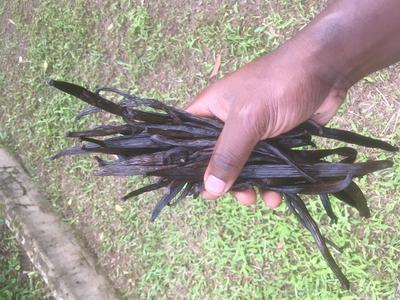VANILLA BEANS | SOYBEAN OIL | SOYMEAL & CAKE | COCOA BEANS | COFFEE BEANS
Madagascar Vanilla

Cure Vanilla Beans
Madagascar vanilla beans
Madagascar vanilla absolute
Madagascar-vanilla
Premium bourbon-madagascar vanilla beans
Madagascar vanilla is considered the world’s gold standard for quality. The country has a globally unmatched reputation and market demand for its high-quality Bourbon vanilla.
The country consistently produces 65–90 percent of total world volume.
The aroma and flavor of Cured Madagascar Vanilla /Bourbon Vanilla is sweet, creamy, rich, fullbodied, tobaccolike, somewhat woody and animal, and deep balsamic, and has sweet spicy back notes.
Madagascar’s Bourbon vanilla is a high-value crop for a Malagasy farmer with as little as 0.5-hectare land size, average annual net income potential isUSD1,500–5,800 per hectare for green vanilla, and USD3,000–9,990 for cured vanilla over a six-year period.
The SAVA Region constitutes one of the twenty-two regions of Madagascar, and is divided into 4 districts, 79 communes and 803 Fokotany. The name SAVA is an abbreviation of the districts (Sambava, Antalaha, Vohemar and Andapa). It is considered home to the Betsimisaraka and Tsimehety ethnic groups, who are the majority ethnic groups in the region. The Sakalava ethnic group, however, dominates the northern Vohemar district. Due to its fertile soils and possibilities to grow cash crops and rice, the region has historically experienced immigration. The SAVA Region is predominantly Christian but there is also a substantial presence of Muslims and adherents to traditional ancestry beliefs. Often traditional beliefs are combined with Christianity.
Madagascar is one of the “hottest biodiversity hotspots”, and the SAVA Region is home to a particularly high share of endemic species. However, the region shows an alarming deforestation rate, and is known for illegal rosewood extraction including extraction from protected areas.
Vanilla was introduced to Madagascar around the year 1880 by colonial France via the neighboring island of La Réunion. The north-eastern part of the island, today the SAVA region, became the vanilla growing region under French colonial rule due to its well adapted climate and geography. Today, the SAVA Region is the largest vanilla producing area worldwide, with an estimated 70,000 smallholder farmers producing 80-90% of the Malagasy bourbon vanilla on ~25,000 hectares of land (ILO 2011). This has made Madagascar the producer of between 50 – 80% of all global vanilla in the past 10 years (FAO stat 2018). Currently, vanilla is Madagascar’s most important export commodity accounting for 19 % of all export value (OEC 2017).
Cultivated by smallholder farmers, vanilla farming is labour-intensive as it is produced using traditional farming methods. Without mechanisation or agricultural inputs, farmer manually clear plots, plant tutor trees and vanilla vines, weed and hand pollinate each vanilla flower.
The approach of the Malagasy government to the vanilla market has changed over the years. Through the 1970s until the early 1980s, the Malagasy government exercised a monopoly over the vanilla market. Agricultural policies emphasized state control of prices and marketing, export taxes on crops, and a protection of the domestic industries (Cadot et al. 2008). The structural adjustment policies of the World Bank from 1995 to 1997 gradually liberalized the vanilla market opening the door for competition, a diversity of actors and a free market system. This process drove up farm gate prices but has contributed to price volatility (Cadot et al. 2008). Ten years ago, the Malagasy Government’s role was restricted to setting the date of vanilla marketing, and setting sanitary and quality inspections (ibid). Currently (2018), several additional regulations exist, ranging from a prohibition of early vanilla harvesting via temporal restrictions on vanilla local transport and international exports to the restrictive issuance of export licences.
With recent dramatic increases in vanilla prices, increasing insecurity came along. Vanilla theft in the fields and in the curing process have become a wide spread problem in the region
Consequently, many farmers spend substantial resources during the last two to three months before harvest guarding their fields against thieves and robbers.
Alternatively, farmers harvest immature vanilla in order to reduce the risk of theft affecting negatively on the quality of the product.
These present major challenges for smallholder farmers in Madagascar of whom the large majority depend on an informal vanilla market beleaguered by a multiplicity of middlemen (Packer 2008,
Fairfood International 2014). Other challenges include the complex production cycle of vanilla and climate-related disasters as the region is regularly hit by cyclones.
These repeating devastations to vanilla fields impact the global vanilla supply and have global impact on its prices (Brown 2007).
In 2003, long droughts across Madagascar followed by a devastating cyclone affected local production – even wiping out much of the warehouse stock.
This caused a boom in prices, which was immediately followed by a dramatic price bust
Following the price spike in 2002-2003, an increasing number of national exporters and international flavour houses started Contract Farming Arrangements (CFAs) with vanilla producers.
Such agreements were virtually absent in the vanilla sector prior to this price spike (Packer 2008, Sielaff et al. 2014).As of today (2019) about 15% of all vanilla farmers in SAVA Madagascar are in CFAs with an exporter, collector or other formal business partner today.
A few international flavour houses have established sourcing centers in the SAVA Region. They are either competing or partnering with traditional collectors, importers and exporters. Contracted vanilla farmers receive a varying combination of benefits. The benefits can include price premiums, access to credit, and support for income diversification, technical assistance, vocational training, educational support and free health insurances.
If you haven't yet found what you were looking for or you need detailed information about the subject matter on this page then... feel free to ask our business travel consultants. |




